Curtiss, Glenn Hammond (1878-1930), an American inventor, made important contributions to the development of aircraft. He manufactured airplanes, and made thousands of planes during World War I (1914-1918). In 1919, a Navy-Curtiss flying boat, commanded by Albert C. Read, made the first flight across the Atlantic Ocean. During the 1920’s, Curtiss’s company designed and built a number of famous racing aircraft.

Curtiss was born in Hammondsport, New York, on May 21, 1878, and educated in the town’s elementary schools. An interest in bicycle racing as a boy eventually led to his flying career. After racing bicycles, he turned to building motorcycles. In 1907, on a motorcycle of his own design, Curtiss reached nearly 137 miles (220 kilometers) per hour during a race. Curtiss’s motorcycle engines attracted the attention of the balloonist Thomas Scott Baldwin, who used them to power his airships. Curtiss built his first airplane engine in 1907. In 1908, he helped design an airplane called the June Bug. It had a box tail and was controlled by ailerons (hinged flaps on the wings). The ailerons caused the plane to roll for more effective turning. Orville and Wilbur Wright had obtained a patent in 1906 on a method of twisting wings to roll a plane. They claimed Curtiss’s ailerons violated their patent. They won a court suit against Curtiss in 1913.
In 1910, Curtiss won $10,000 by flying one of his planes, the Albany Flier, from Albany, New York, to New York City in 2 hours 51 minutes. He built the first planes for the United States Navy in 1911 after demonstrating that planes could land and take off from ships. He is thus sometimes called the Father of Naval Aviation. Curtiss died on July 23, 1930.
